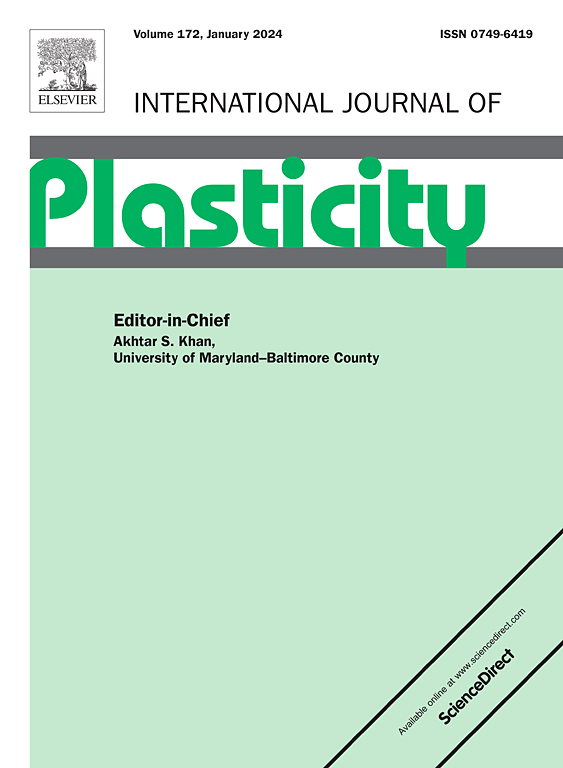钝化裂纹尖端附近氢输运的完全动力学模型
IF 12.8
1区 材料科学
Q1 ENGINEERING, MECHANICAL
引用次数: 0
摘要
氢的扩散和俘获动力学在金属氢脆中起主要作用。在机械载荷作用下,氢受静流体应力驱动,由于对氢的亲和作用而在位错处积累。然而,大多数应力扩散模型依赖于Oriani的局部平衡假设,该假设将位错处的氢积聚视为瞬时过程。因此,这些模型本质上不能描述实验中观察到的加载速率灵敏度。为了克服这一限制,我们提出了一个完全动力学的公式,其中氢-位错相互作用被建模为由归一化位错密度的空间梯度驱动的扩散通量。结合Taylor硬化模型,采用Kocks-Mecking-Estrin方程求解位错密度的演化过程。与经典模型相比,我们的公式将氢的总浓度作为一个单一的物种来求解,从而无需人为地将氢划分为晶格和捕获的物种。结果表明,加载速度越慢,裂纹尖端的氢积累越多。此外,通过允许局部扩散率作为位错密度的函数而变化,自然地纳入了管扩散。我们还证明,正确的边界条件需要规定兼顾应力和位错效应的平衡浓度,从而确保化学势与远场晶格的连续性。这项工作为氢延迟裂缝建模提供了一个强大的、可扩展的框架。本文章由计算机程序翻译,如有差异,请以英文原文为准。
A fully kinetic model for hydrogen transport near a blunting crack tip
The kinetics of hydrogen diffusion and trapping play a major role in hydrogen embrittlement in metals. Under mechanical loading, hydrogen is driven by hydrostatic stress and accumulates at dislocations due to their affinity for hydrogen. However, most stress-diffusion models rely on Oriani’s local equilibrium assumption, which treats hydrogen buildup at dislocations as an instantaneous process. As a result, these models inherently fail to describe the loading rate sensitivity observed in experiments. To overcome this limitation, we propose a fully kinetic formulation in which hydrogen-dislocation interactions are modeled as a diffusive flux driven by the spatial gradient of the normalized dislocation density. The Kocks–Mecking–Estrin equation is used for the evolution of dislocation density coupled with Taylor hardening model. In contrast to classical models, our formulation solves for the total hydrogen concentration as a single species, thereby removing the need to artificially partition hydrogen into lattice and trapped species. The results show that slower loading rates lead to greater hydrogen accumulation at the crack tip. Additionally, pipe diffusion is naturally incorporated by allowing the local diffusivity to vary as a function of dislocation density. We also demonstrate that correct boundary conditions require prescribing equilibrium concentration that account for both stress and dislocation effects, ensuring chemical potential continuity with the far-field lattice. This work provides a robust and extensible framework for modeling hydrogen delayed fracture.
求助全文
通过发布文献求助,成功后即可免费获取论文全文。
去求助
来源期刊

International Journal of Plasticity
工程技术-材料科学:综合
CiteScore
15.30
自引率
26.50%
发文量
256
审稿时长
46 days
期刊介绍:
International Journal of Plasticity aims to present original research encompassing all facets of plastic deformation, damage, and fracture behavior in both isotropic and anisotropic solids. This includes exploring the thermodynamics of plasticity and fracture, continuum theory, and macroscopic as well as microscopic phenomena.
Topics of interest span the plastic behavior of single crystals and polycrystalline metals, ceramics, rocks, soils, composites, nanocrystalline and microelectronics materials, shape memory alloys, ferroelectric ceramics, thin films, and polymers. Additionally, the journal covers plasticity aspects of failure and fracture mechanics. Contributions involving significant experimental, numerical, or theoretical advancements that enhance the understanding of the plastic behavior of solids are particularly valued. Papers addressing the modeling of finite nonlinear elastic deformation, bearing similarities to the modeling of plastic deformation, are also welcomed.
 求助内容:
求助内容: 应助结果提醒方式:
应助结果提醒方式:


